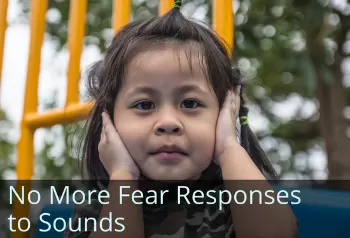Primitive Reflex Integration Case Studies
5-Year-Old Gains Sensory Integration and Motor Planning
Submitted by Monica Carlson, MOT OTR/L

| Before | After |
|---|---|
| Required assistance and multiple trials for motor planning when moving from quadruped > half kneel > standing | Moves through these steps with SBA [Safety-Behavior Availability] only, fair trunk rotation, and no extra time needed to plan the sequence |
| Exhibited strong fear responses to sounds like rain and the dishwasher | Improved tolerance to auditory input |
Patient “A” is age 5 y/o with a frontal encephalocele and hypotonia. A’s challenges include low muscle tone, decreased body awareness, decreased static and dynamic balance, visual-motor skills, decreased grasping skills, sensory sensitivities and decreased independence with ADL. Her OT goals include pre-writing stroke formation (A is showing emerging awareness of letter formation but primarily traces letters), hand strengthening and bilateral coordination skill development and increasing independence at home.
She presented with signs of an active TLR [Tonic Labyrinthine Reflex] (balance difficulties, jerky movements, limited core strength, muscle tone imbalances), ATNR [Asymmetrical Tonic Neck Reflex] (poor focus, difficulty crossing the midline, poor gross and fine motor skills, difficulty with coordination, slow ambulation, poor and awkward writing position, challenges with handwriting, poor bilateral integration), active STNR (weak muscles, difficulty writing, difficulty staying on task) and active grasp reflexes (poor fine motor skills, speech problems, difficulty with handwriting). Her mom also had concerns about strong fear responses to sounds like rain and the dishwasher.
We used tools for TLR, ATNR, STNR [Symmetrical Tonic Neck Reflex], and hand reflexes [from the Brain and Sensory Foundations course]. For TLR, we completed sitting head flexion/extension due to risks for falls in standing to target stimulation. We then engaged in LOTS of rolling, rocking and floor games as well as rhythmic movements. I chose these activities based on relevance and pt enjoyment and engagement. Due to her strong fear responses and other signs of anxiety, we utilized FPR [Fear Paralysis Reflex] and Moro [tools from the Brain and Sensory Foundations course].
A had great difficulty finding her own rhythm and often needed my assistance. As time went on, her mother stated that she would fold the developmental playful movements into her own play schemes. Currently, patient can complete rhythmic movements on her own for periods of 10-20 seconds before losing her rhythm – a big improvement!
I noticed the biggest improvement in moving from quadruped>half kneel>standing with patient initially needing minimal physical assistance and multiple trials for motor planning the task. Now, A will move through these steps with SBA [Safety-Behavior Availability] only, fair trunk rotation and no extra time needed to plan the sequence!
A also improved her tolerance to auditory input. She can now tolerate the sound of the dishwasher without any distress and more recently became tolerant of rain! During the last rainstorm, mom even stated that she had NO aversive response!
I worked with A using these movements from October, 2021- current (April, 2022) during weekly one hour OT sessions.
I learned that many therapists want to jump to the higher-level skills, but once you examine some of the underlying neurological deficits, you may find bigger foundational areas of concern. I learned that the developmental movements can be very easy to fold into “typical” therapy sessions.
[Edited, emphasis added]
*Disclaimer: The activities in the Brain and Sensory Foundations curriculum make use of the natural processes of neuroplasticity and development that are innately wired in the design of human beings to promote maturity and function. These activities appear to calm, organize, and mature the neuro-sensory-motor systems just as we see in the healthy development of human infants. Individual results may vary, and we do not claim to offer a diagnosis or cure for any specific condition or disorder. The Brain and Sensory Foundations activities appear to improve overall functioning resulting in measurable improvements for a range of conditions as demonstrated in over 1800 case studies from participants.

